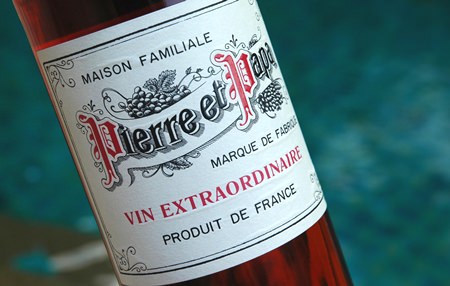The French expression vin ordinaire doesn’t translate as easily as it might appear because in English, “ordinary wine” sounds a bit disparaging. Technically it’s classed as vin de table which is the lowest level of French wine you can buy. Some vin ordinaire can actually be quite good and finds its way on to many a French dining table.
It just doesn’t have the character, intensity and superior qualities of more expensive wines. The wines this week both carry the IGP designation which stands for Indication Géographique Protégée, which basically means that the wine is guaranteed to be from the place it says on the label. In this case, it’s the district of Hérault in southern France. So it’s a notch up from ordinary vin ordinaire.

You’ll find Hérault (assuming that you have the desire to do so) near the Mediterranean coastline around the town of Béziers. Most of the vineyards lie on the lower slopes of the Montagne Noire hills and on the broad coastal plains below. It’s part of the vast Languedoc-Roussillon region that stretches from the middle of Southern France down to the Spanish frontier in the west. It’s a pleasant place to potter about, with rolling hills, endless miles of winding country roads, one-horse towns and of course countless acres of vineyards.
This week’s wines are easily recogniseable by their rustic labels. They’re pretty basic country wines but none the worse for that. The company also produces a crisp and tangy dry white wine made from Colombard. These are wines to drink young because they won’t improve with age. In fact, the opposite will happen. You might be surprised to know that only a very small percentage of the world’s wines derive any benefit from ageing. Nearly all wines are designed to taste their best when they’re young and should be consumed no more than two or three years after production. So don’t keep that special bottle at the back of the cupboard for years, in the vague hope that it will mysteriously improve. It almost certainly won’t.
Pierre et Papa Vin Extraordinaire 2012 (rosé), Pays d’Hérault IGP, France (Bt. 449 @ Wine Connection)
Now that the weather is becoming a bit warmer, it’s time to think about getting in some rosé. Of course, you can drink rosé at any time of year, especially in Thailand but to my mind, rosé is best in warm weather, served ice cold. Rosé wines are nearly always light and refreshing and there’s a good choice of them in most wine outlets. The best and lightest invariably come from France. This one is a very pale pink, slightly paler than smoked salmon. Just to check, I got a pack of New Zealand smoked salmon out of the fridge to compare the colours. Yes, I know – sad but true. I really must try and get out a bit more.
The wine is made from the Cinsault (SAN-soh) grape, which is one of the most planted grapes in southern France and nearly always used for blending. Strangely enough, no one seems to know exactly where it originated, though it almost certainly hails from the warm countries surrounding the Mediterranean. We know this because Cinsault prefers very warm conditions and too much rain causes the grapes to rot. Cinsault can produce huge crops of six to ten tons per acre, but at this level the resulting wines are uninteresting. At lower crop levels it produces attractive, easy-drinkers with perfumed aromas and soft tannins.
This wine has a lovely delicate smell of red fruit along with vague hints of pear and cherry. And that’s about it, because Cinsault is not known for symphonic aromas. The wine is very light-bodied and fairly dry, although not totally so. On a scale from zero to five in which zero is totally dry, I’d put this wine at about 1.5. There’s hardly any acidity but a good balance of delicate fruit on the palate and a surprisingly long finish. It’s a really easy glugger and at 12.5% alcohol content it’s so light that you can enjoy it on its own, but it was quite successful with the smoked salmon.
The important thing is to serve rosé very cold indeed. When the wine starts to warm up in the glass, which in this country it will do all too quickly, it rapidly loses freshness and bite and becomes dull and flabby. So before you drink it, stick the bottle in the freezer for about forty-five minutes, down among the French fries and the chicken nuggets. Don’t let me catch you dishing up this wine at anything higher than 4°C, otherwise you’ll receive a severe poke with a pointed wooden stick.
I have to admit that much as I enjoy rosé, the thought of drinking it all evening doesn’t have much appeal, because after a time there’s a need for something with a bit more character and interest. A glass of light red would do nicely.
Pierre et Papa Vin Extraordinaire 2012 (red), Pays d’Hérault IGP, France (Bt. 449 @ Wine Connection)
This one is light indeed and made from a fairly typical blend of Grenache and Carignan grapes, both of which originated in Spain. On their own, these grapes tend to produce rather ordinary, featureless wines and so they’re often blended together to make something more interesting. Carignan originally hailed from the Cariñera district in Aragon (hence the name) but it’s now the most widely-grown red grape in France, especially in the Languedoc-Roussillon region.
The wine is a vibrant red with attractive aromas of soft fruit, notably redcurrant and cherry, but you might detect hints of herbs and brambles in the background. It’s very dry, pleasantly light-bodied, lots of fresh fruit on the palate and an attractive fruity finish with just the slightest touch of firm tannin, which I’d guess comes from the Carignan in the blend. Nevertheless, it’s a pretty basic everyday drinker and while the word “extraordinaire” is not the first adjective that springs to mind, it’s a pleasant enough wine. It also has a dash of light acidity so it would probably go well with pasta or pizza if you don’t happen to have an Italian wine in the house. Light reds like this one usually taste their best slightly on the cool side, though not actually ice cold. I’d guess that around 12°C would be about right.




